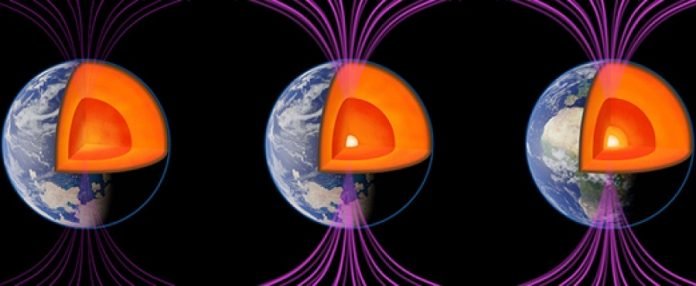
Earth’s solid inner core formed 550 million years ago and restored the planet’s magnetic field.
Approximately 1,800 miles beneath our feet, swirling liquid iron in the Earth’s outer core generates the planet’s protective magnetic field.
The magnetic field is invisible but is vital for life on Earth’s surface because it shields the planet from solar wind—streams of radiation from the sun.
About 565 million years ago, however, the magnetic field’s strength decreased, to a level only 10% of the strength it has today.
Then, mysteriously, the field bounced back, regaining its strength just before the explosion of multicellular life on Earth.
What caused the magnetic field to bounce back?
According to U.S. National Science Foundation-supported research by scientists at the University of Rochester, the rejuvenation happened within a few tens of millions of years—rapid on geological timescales—and coincided with the formation of Earth’s solid inner core, suggesting that the core is likely a direct cause.
“The inner core is tremendously important,” says John Tarduno, one of the authors of a paper published in Nature Communications.
“Right before the inner core started to grow, the magnetic field was at the point of collapse, but as soon as the inner core started to grow, the field was regenerated.”
The researchers determined several key dates in the inner core’s history, including a more precise estimate for its age. The research provides clues about the history and future evolution of Earth and how it became a habitable planet, as well as the evolution of other planets in the solar system.
“This study adds to our understanding of the Earth’s magnetic field and inner core, which helps us better comprehend the evolution of planets and life in the past and present,” says Eva Zanzerkia, a program director in NSF’s Division of Earth Sciences.
Earth is composed of layers: the crust, where life is situated; the mantle, Earth’s thickest layer; the molten outer core; and the solid inner core, which is, in turn, composed of an outermost inner core and an innermost inner core.
Earth’s magnetic field is generated in its outer core, where swirling liquid iron causes electric currents, driving a phenomenon called the geodynamo that produces the magnetic field.
Because of the magnetic field’s relationship to Earth’s core, scientists have been trying for decades to determine how Earth’s magnetic field and core have changed throughout our planet’s history.
They cannot directly measure the magnetic field because of the location and extreme temperatures of materials in the core. Fortunately, minerals that rise to Earth’s surface contain tiny magnetic particles that lock in the direction and intensity of the magnetic field at the time the minerals cool from their molten state.
To better define the age and growth of the inner core, Tarduno and his team used a carbon dioxide laser and the lab’s superconducting quantum interference device magnetometer to analyze feldspar crystals from the rock anorthosite.
These crystals have minute magnetic needles within them that are “perfect magnetic recorders,” Tarduno says.
Better understanding the dynamics and growth of the inner core and the magnetic field has important implications, not only in uncovering Earth’s past and predicting its future, but in unraveling the ways in which other planets might form magnetic shields and sustain the conditions necessary to harbor life.
Researchers believe that Mars, for example, once had a magnetic field, but the field dissipated, leaving the planet vulnerable to solar wind and the surface oceanless.
While it is unclear whether the absence of a magnetic field would have caused Earth to meet the same fate, “Earth certainly would’ve lost much more water if Earth’s magnetic field had not been regenerated,” Tarduno says. “The planet would be much drier and very different than the planet today.”
In terms of planetary evolution, then, the research emphasizes the importance of a magnetic shield and a mechanism to sustain it, he says.
“This research really highlights the need to have something like a growing inner core that sustains a magnetic field over the entire lifetime—many billions of years—of a planet.”



